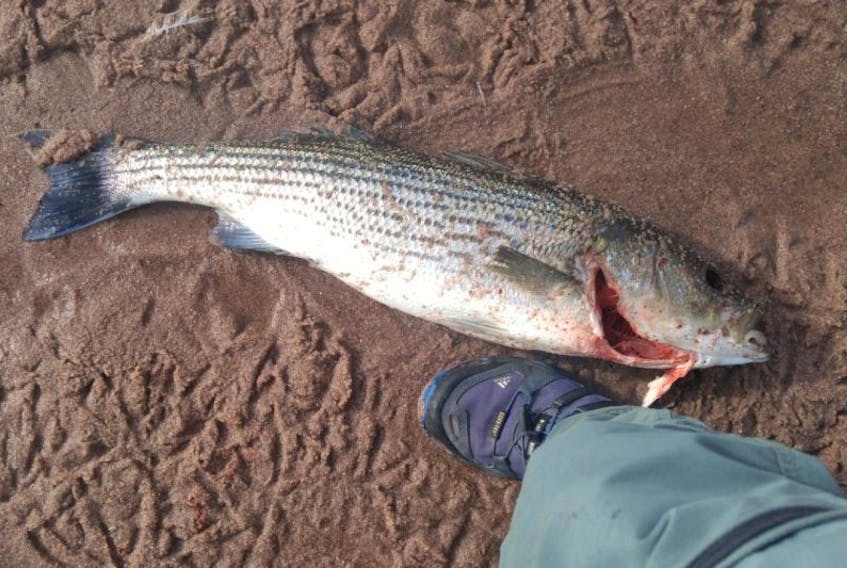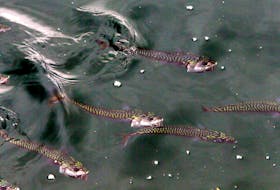This week, though, he saw something he has never seen before.
In fact, when the now-retired harvester went down to the sandy beaches in L’Anse au Clair to see what his friend wanted to show him, he had no idea what it was he was looking at.
The sight that awaited him was about 50 dead striped bass washed up on the sandy estuary where the river in town runs into the Strait of Belle Isle.
“I didn’t know what they were,” he said Friday. “I used to drag for cod fish and I never, ever seen them before. There must be some changes going on somewhere for them to be here now.”
It is peculiar for striped bass to be in the southern Labrador coast area. An anadromous species — like salmon, which can swim in both salt and fresh water, striped bass are usually found along the Atlantic coast only as far north as the southern Gulf of St. Lawrence.
Several social media posts in the past week have indicated they are now being found in fair abundance along the north shore of Quebec. Their presence in the L’Anse au Clair area shows they’ve wandered even further north.
Striped bass are known as diverse and advantageous eaters that will feed on numerous saltwater and freshwater species.
The fact there are low number of caplin, herring and salmon in the waters this year has Thomas wondering what sort of impact the invasion of striped bass might also have on these stocks.
“There’s something gong on,” he said. “This is one of the worst years I’ve ever seen. It concerns me, but it doesn’t affect me too much because I’m retired.”
The Saltwire Network requested an interview with an official from the Department of Fisheries and Oceans about the presence of striped bass in the waters of southern Labrador, but no one was made available.
In an emailed response, DFO confirmed it was aware of striped bass being caught and observed in Labrador and that this was further north than their normal range.
“The striped bass appearing along the north shore of Quebec, and seen recently in rivers along southern Labrador, are likely from the St. Lawrence River population,” read the emailed statement. “It is not uncommon, this time of year, when ocean temperatures are warmer that we see occurrences of warm water fish travelling further north.”
There is a page on the DFO website dedicated to frequently asked questions about striped bass. While there is no mention of the fish moving northwards in the Gulf of St. Lawrence, the page — which was last modified June 16 — does note that the recovery of the once-depleted striped bass stocks in recent years has been extraordinary.
Recent news coverage in New Brunswick reported the striped bass population there had exploded and was causing concerns for salmon conservation groups.
The DFO page makes reference to the low returns of Atlantic salmon recorded this summer, but says low salmon returns are being experienced in areas of Atlantic Canada where there are no striped bass.
The website also notes that the stomach contents of striped bass examined during a recent three-year study have shown only a low proportion of salmon smolts.
Studies conducted by DFO in Atlantic Canada and Quebec indicate there is little or no population-level impact on salmon. However, similar studies have not been conducted in Newfoundland and Labrador, as this species does not typically occur here.
DFO said it will continue to study interactions among species, including in Newfoundland and Labrador.
Weblink: http://bit.ly/2wPIhQH
Fact Box
• The natural range of the striped bass extends along the Atlantic coast of North America, from the St. Lawrence Estuary to the St. Johns River in northeast Florida.
In Canada, five native striped bass populations have existed in three distinct sectors corresponding to the three designated units: the Bay of Fundy, the Southern Gulf and the St. Lawrence Estuary. The St. Lawrence Estuary population, which is thought to be isolated from other Canadian populations, occupies a 300-kilometrem stretch of the St. Lawrence River and Estuary.
• The striped bass, St. Lawrence River population, is protected under the federal Species at Risk Act.
•Striped bass are typically associated with estuaries and coastal waters. They travel along the coast in compact schools of same-size fish, feeding on invertebrates and fish. It is an anadromous fish — spawning, incubation and early larval development occurs in freshwater in the spring. The young subsequently move downstream to brackish water and then on to saltwater where they feed and grow until they reach maturity.
A particular feature of Canadian striped bass populations is that they overwinter in rivers to escape the cold ocean waters. An abundant striped bass population is an indicator that a river and its estuary are in good condition: the species requires high quality spawning and nursery habitat and abundant aquatic species for food.
• Striped bass were once abundant on the Lower North Shore of Quebec, but the species virtually disappeared because of overfishing during the 1960s. Young striped bass were reintroduced into the waters of eastern Quebec in the 2000s. While overall abundance in the long term is not yet known, abundance this year has been good.









